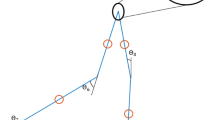Abstract
Human postural movements can be simulated by a biomechanical model. Biomechanical models, however, involve differential equations and do not admit conventional optimization techniques for solution. Introducing the notion of dynamic grid-sizing, this paper presents an easy-to-implement simulation-based heuristic procedure for solving biomechanical models. We adopt the four-segment sagittal model for human postural analysis from [Iqbal K, Pai YC (2000) Predicted region of stability for balance recovery: motion at the knee joint can improve termination of forward movement. J Biomech 33:1,619–1,627] for illustration and solve it to predict a region of stability for the model. The size and the feasibility of the stability region predicted by the proposed scheme in comparison with results reported in (Iqbal K, Pai YC (2000) Predicted region of stability for balance recovery: motion at the knee joint can improve termination of forward movement. J Biomech 33:1,619–1,627) demonstrate that the proposed scheme is fairly efficient and effective and further suggest its practical usage in analyzing human postural balance.





Similar content being viewed by others
References
Anderson FC, Pandy MG (2001) Dynamic optimization of human walking. J Biomech Eng 123:381–390
Baker SP, Harvey AH (1985) Fall injuries in the elderly. Clin Geriatr Med 1:501–512
Connell BR (1996) Role of the environment in falls prevention. Clin Geriatr Med 12:859–880
Edwards WT (2001) Comments on predicted region of stability for balance recovery: motion at the knee joint can improve termination of forward movement. J Biomech 34:831–832
Goldberg D (1989) Genetic algorithms in search, optimization and machine learning. Addison–Wesley, Massachusetts
Hayes WC, Myers ER, Robinovitch SN, van den Kroonenberg A, Courtney AC, McMahon TA (1996) Etiology and prevention of age-related hip fractures. Bone 18:77S–86S
Iqbal K, Pai YC (2000) Predicted region of stability for balance recovery: motion at the knee joint can improve termination of forward movement. J Biomech 33:1619–1627
Konieczynski DD, Truty MJ, Biewener AA (1998) Evaluation of a bone’s in vivo 24-hour loading history for physical exercise compared with background loading. J Orthop Res 16:29–37
Kuo D (1995) An optimal control model for analyzing human postural balance. IEEE Trans Biomed Eng 42(1):87–101
Menegaldo LL, Fleury AdT, Weber HI (2003) Biomechanical modeling and optimal control of human posture. J Biomech 36:1701–1712
Onyshko S, Winter DA (1980) A mathematical model for the dynamics of human locomotion. J Biomech 13:361–368
Pai YC, Patton JL (1997) Center of mass velocity—position predictions of balance control. J Biomech 30:347–354
Pavol MJ, Pai YC (2002) Feedforward adaptations are used to compensate for a potential slip during a sit-to-stand. Exp Brain Res 145:528–538
Pavol MJ, Runtz EF, Edwards BJ, Pai YC (2002) Age influences the outcome of a slipping perturbation during initial but not repeated exposures. J Gerontol Med Sci 57:M496–M503
Shroyer JL (1994) Recommendations for environmental design research correlating falls and the physical environment. Exp Aging Res 20:303–309
Studenski S, Rigler SK (1996) Clinical overview of instability in the elderly. Clin Geriatr Med 12:679–688
Turner CH (1991) Toward a cure for osteoporosis: reversal of excessive bone fragility. Osteoporos Int 2:12–19
van den Bogert AJ, Pavol MJ, Grabiner MD (2002) Response time is more important than walking speed for the ability of older adults to avoid a fall after a trip. J Biomech 35:199–205
Winter DA (2005) Biomechanics and motor control of human movements, 3rd edn. Wiley, Hoboken
Yang JF, Winter DA, Wells RP (1990) Postural dynamics of walking in human. Biol Cybern 62:321–330
Author information
Authors and Affiliations
Corresponding author
Rights and permissions
About this article
Cite this article
Ryoo, H.S., Ayyalasomayajula, P. A simulation-based heuristic solution procedure for analyzing human postural balance. OR Spectrum 28, 399–415 (2006). https://doi.org/10.1007/s00291-005-0030-3
Published:
Issue Date:
DOI: https://doi.org/10.1007/s00291-005-0030-3




